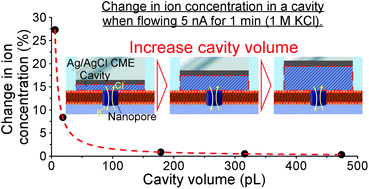Microcavity volume control on a tip of Ag/AgCl electrodes for stable channel current measurements of biological nanopores†
Abstract
A probe-type channel current measurement system with a planer bilayer lipid membrane (pBLM) at the tip of a probe provided several advantages for pBLM formation and channel current measurements. The procedure for preparing pBLMs was simple (i.e., the probe was submerged into a bath solution layered by an oil/lipid mixture and buffer solution). The probe systems offered local detection of analytes by nanopore sensing. Nevertheless, the current decay caused by changing the ion concentration in the electrolyte held on the tip of the probes influenced the sensing accuracy. Here we applied a cavity microelectrode (CME) technique to fabricate pBLM probes with larger electrolyte volume on the tip. We fabricated silver CMEs with different cavity volumes and measured channel currents of biological nanopores. Furthermore, we evaluated the channel current decay as a function of cavity volume by analyzing the step signals of α-hemolysin nanopores. Consequently, the channel current decay was extended by increasing the cavity volume, indicating that the volume of the electrolyte solution was important for channel current measurements of nanopores. We concluded that the pBLM system using CMEs is useful for channel current measurements of biological nanopores. Additionally, the fundamental evaluation of the relationship between the electrolyte volume and channel current decay will be helpful in the design of pBLM systems made by microfabrication and microfluidic techniques.



 Please wait while we load your content...
Please wait while we load your content...